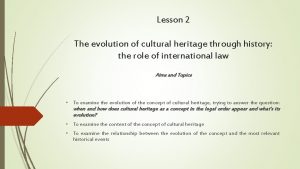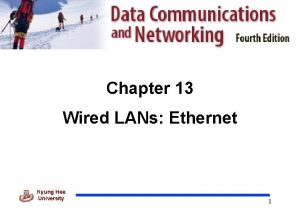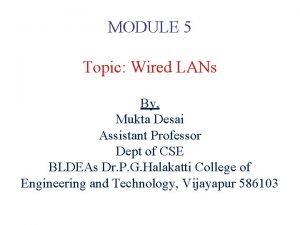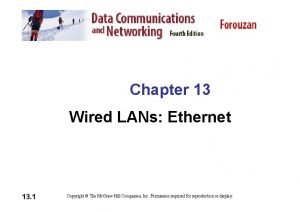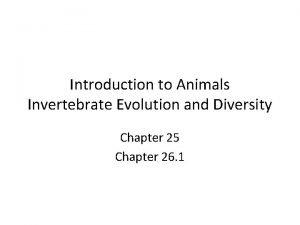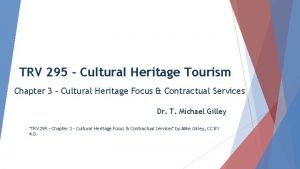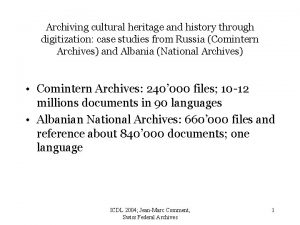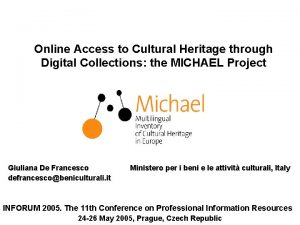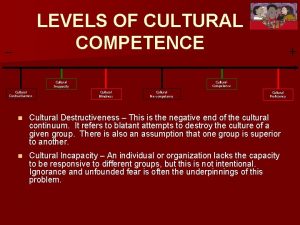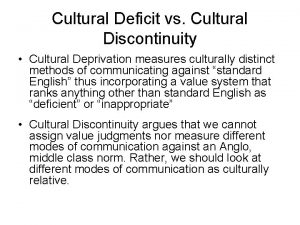Lesson 2 The evolution of cultural heritage through













































- Slides: 45

Lesson 2 The evolution of cultural heritage through history: the role of international law Aims and Topics • To examine the evolution of the concept of cultural heritage, trying to answer the question: when and how does cultural heritage as a concept in the legal order appear and what’s its evolution? • To examine the content of the concept of cultural heritage • To examine the relationship between the evolution of the concept and the most relevant historical events

What are we discussing? As we told, «cultural heritage» as a legal concept is very recent and modern, and the different manner through wich a State approaches the matter depends on the different political and historical basis of the State itself. As we also told the legal order contains different levels of legislation: regional, national, supranational, international. In this lesson we’ll observe the most relevant role of the international law, as it is at this level «cultural heritage» has been defined as a legal concept. Supranational level Regional level National level Cultural heritage International level

…from the past… No rules prevented armed forces from devastating a country or from seizing the enemy’s goods, the destruction of cultural property being then considered an inevitable consequence of war. Xenophon, Cyropaedia Cicero, Actionis in C. Verrem secundae liber quartus, De officiis ad Marcum filium, De republica Middle Ages: Germanic armies and Crusaders The Synod of Charroux (989) Edict of the Emperor Frederick I 1158

…from the Renaissance… The Pope Martino V° proclaimed the protection of ancient buildings and monuments in 1425 Other laws were introduced during the further years for example by the Medici or in Rome

…the first conceptualization… Jacob Przvluski, Leges seu statuta ac privilegia Regni Poloniae, Cracow, 1553 Alberic – Justin Gentilis, Dissertatio de eo quod in bello licet, 1690 Hugo Grotius, De iure belli ac pacis libri tres, translated by Clarendon Press, 1925 Emerich De Vettel, The Law of Nations or the Principles of natural law, applied to the Conduct and to the Affairs of Nations and of Sovereigns, 1758 J. J. Rousseau, Le contrat social Peace of Westphalia – 1648 Lord Castlereagh 1815

…from other worlds… In pre-colonial Africa places where fetishes were kept, places where initiation were held, were all protected The people of Tallensi strictly forbade any kind of pillage which would confer personal advantage In Japan, Emperor Go-Daigo, in 1339, sent his army to put down a rebellion but he strictly forbade setting fire to shrines and temples Under Islamic Law the obligation to distinguish between civilian and military objects is clearly imperative and permits no exception. Caliph Abu Bakr gave order never to destroy palm trees, burn dwellings or cornfields, cut down fruit trees, kill livestock unless constrained by hunger, and never to lay hands on monasteries

The Lieber Code - 1863 The so-called «Lieber Code» (from the name of his author) was titled Instructions for the Government of Army of United States and printed in 1863. There were some articles explicitly devoted to the problem of cultural objects: Art. 31 Art. 35 Art. 36

The Lieber Code: content and comments Art. 31: «it recognized the appropriation of public money» Art. 34: «it established, as a general rule, the property belonging to churches, to hospitals or other establishments of an exclusively charitable nature, to establishments of education, or foundations for the promotion of knowledge, whether public schools, universities, academies of learning or observatories, museums of the fine arts, or of a scientific character – such property is not to be considered public property in the sense of Article 31; but it may be taxed or used when the public service may require it» Art. 35: «classical works of art, libraries, scientific collections or precious instruments, such as astronomical telescopes, as well as hospitals, must be secured against all avoidable injury, even when they are contained in fortified places whlst besieged or bombarded» Art. 36: «if such works of art, libraries, collections or instruments belonging to a hostile nation or government, can be removed without injury, the ruler of the conquering state or nation may order them to be seized and removed for the benefit of the said nation. The ultimate ownership is to be settled by the ensuing treaty of peace. In no case shall be they sold or given away, if captured by the armies of the United States, nor shall be they ever be privately appropriated, or wantonly destroyed or injured» J. G. Bluntschli, Das moderne Völkerrecht der civilisierten Staaten als Rechtbuch dargestellt, 1868

Other documents The Brussels Declaration – 1874: «the property of municipalities, that of institutions dedicated to religion, charity and education, the arts and sciences, even when State property, shall be treated as private property. All seizure or destruction of, or wilful damage to, institutions of this character, historic monuments, works of art and science, should be made the subject of legal proceedings by the competent authorities» Art. 13 permitted the seizure or destruction of everything needed by the enemy in order to wage war or of anything which could reinforce the enemy; artt. 16 -17: «if a town or fortress, agglomeration of dwellings, or village, is defended, the officere in command of an attacking force must, before commencing a bombardment take all necessary steps to spare, as far as possible, buildings dedicated to art, science, or charitable purposes» ; it also estabished the duty «of the besieged to indicate the presence of such buildings by distinctive and visible signs to be communicated to the enemy beforehand» . The concept of property to be preserved included also religious buildings to meet the request of the Turkish delegate to cover also non-christian religious buildings The Manual of the Institute of International Law, adopted in the session held in Oxford in 1880 (the so-called Oxford Manual) – The Laws and Customs of War on Land repeated almost all the principles introduced by the Brussels Declaration

The International Peace Conferences – 1899 - 1907 With the development of modern wars – since the beginning of XXth Century – a new attention began to be given to the problem of the protection of cultural property, especially from the damaging effects of attacks, besieges and bombardaments. Aerial attacks pointed out the new tremendous destructive power of new technologies, and international authorities, States and intergovernmental conferences and bodies began to give a growing attention to the matter. In this direction we have to consider two first Conference, where the problem of cultural property was firstly discussed: the first was that one of 1899, the second, and particularly important, that one of 1907.

The International Conference of 1907 It took place in the city of The Hague, as usually it happened for this kind of conference, as The Hagues remained a neutral city during the period of war. The Hague Conventions or Conferences had a great development especially in the period around the two World Wars. These Conventions and Conferences gave attention and introduced rules against damages and destructions both considering the civilian property in general, and the cultural property in particular. The Regulations of 1907, annexed to Convention n° IV, introduced rules around the protection of cultural property in articles 27 and 56. Art. 27 (Section Hostilities – Chapter I Means of Injuring the Enemy, Sieges and Bombardments) states: In sieges and bombardments all necessary steps must be taken to spare, as afar as possible, buildings dedicated to religion, art, science, or charitable purposes, historic monuments, hospitals, and places where the sick and wounded are collected, providing they are not being used at the same time for military purposes. It is the duty of the besieged to indicate of such buildings or places by distinctive and visible signs, which shall be notified to the enemy beforehand. Military necessity Territorial restrictions Indications and signs

The rules of 1907 – art. 56 It takes place under the Section III – Military authority over the territory of the hostile State. The property of municipalities, that of institutions dedicated to religion, charity and education, the arts and sciences, even when State property, shall be treated as private property. All seizure of, destruction or wilful damage done to institutions of this character, historic monuments, works of art and science, is forbidden, and should be made the subject of legal proceedings. It rounds off Articles 53 and 55, that establish some rules around power and authority of the occupying power, distinguish between State and companies and private individuals. Article 56 doesn’t contain dinstinction and the property indicated in the different categories have to be treated as private property. They are, in particular, a) Property of municipalities; b) Institutions dedicate to religion, charity and education, the arts and sciences; c) Historic monuments; d) Works of art and science.

The Regulations of 1907 The exception of bombardments by naval forces Art. 5: In bombardments by naval forces all the necessary measures must be taken by the commander to spare as far as possible sacred edifices, buildings used for artistic, scientific, or charitable purposes, historic monuments, hospitals, and places where the sick and wounded are collected, on the understanding that they are not used at the same time for military purposes. It is the duty of the inhabitants to indicate such monuments, edifices, or places by visible signs, which shall cosist of large, stiff rectangular panels, divided diagonally into two coloured trinagular portions, the upper portion blacck the lower portion white. Protected and non protected places Oxford Manual 1913 Protection of buildings not used for military purposes

The First World War Dutch Archaelogical Society Conference proposal on the protection of historic and artistic buildings and objects Mr. Vetter – Berne Mr. Mariaud – Geneve Public gathering Geneve – april 1915 La Croix d’Or Commission on Responsibility for War and Guarantees – january 1919 Conference Brussels – August 1915 Germany – Austro-Hungary - Switzerland Preliminary Conference to Versailles Punishing responsibilities for violations of Hague rules Van Eysinga’s document 31 October 1918

The Hague Rules Concerning the Control of Radio in Time of war and Air Warfare - 1922 They were adopted by a Commission of Jurists established by the Washington Conference of 1922 on the limitation of Armaments with the resolution of 4 February 1922. The Commisson was composed of representatives of France, Italy, Japan, the Netherlands, United Kingdom and United States, and presided by John Bassett Moore. It met from December 1922 to February 1923 at The Hague. The rules prepared in the report were never adopted in legally binding form, but they had importance as «an authoritative attempt to clarify and formulate rules of law governing the use of aircraft in war» .

The Hague Rules Concerning the Control of Radio in Time of War and Air Warfare - 1922 Principles and details They introduced the distinction between general protection and special protection They abandoned the criterior of defence and replaced it with a new approach concerning the military objective. Art. 25: in bombardment by aircraft, all necessary steps must be taken by the commander to spare as far as possible buildings dedicated to public worship, art, science, or charitable purposes, historic monuments, hospital ships, hospitals and other places where the sick and wounded are collected, provided such buildings, objects or places are not at the time used for military purposes. Such buildings, objects and places must by day indicated by marks visible to aircraft. The use of marks to indicate other buildings, objects, or places than those specified above is to be deemed an act of perfidy. The marks used as aforesaid shall be in the case of buildings protected under the Geneva Convention the red cross on a white ground, and in the case of other protected buildings a large rectangular panel divided diagonally into two pointed trinagular portions, one black and the other white. A belligerent who desires to secure by night the pprotection for the hospitals and other privileged buildings above mentioned must take the necessary measures to render the special signs referred to sufficiently visible.

The Hague Rules Concerning the Control of Radio in Time of War and Air Warfare - 1922 Art. 26: The following special rules are adopted for the purpose of enabling states to obtain more efficient protection for important historic monuments situated within their territory, provided that they are willing to refrain from the use of such monuments and a surrounding zone for military purposes, and to accept a special regime for their inspection: 1. A state shall be entitled, if it sees fit, to establish a zone of protection round such monuments situated in its territory. Such zones shall in time of war eenjoy immunity from bombardment. 2. The monuments round which a zone is to be established shall be notified to other Powers in peace time through the diplomatic channel; the notification shall also indicate the liits of the zones. The notification may not be withdrawn in time of war. 3. The zone of protection may include, in addition to the area actually occupied by the monumeent or group of monuments, an outer zone, not exceeding 500 metres in width, measured from the circumference of the said area. 4. Marks clearly visible from aircraft either by day or by night will be employed for the purpose of ensuring the identification by belligerent airmen of the limits of the zones. 5. The marks on the monuments themselves will be those defined in article 25. The marks employed for indicating the surrounding zones will be fixed by each state adopting the provisions of this article, and will be notified to other Powers at the same time as the monuments and the zones are notified. 6. Any abusive use of the marks indicating the zones referred to in paragraph 5 will be regarded as an act of perfidy. 7. A state adopting the provisions of this article must abstain from using the monuments and the surrounding zones for military purposes, or for the benefit in any way whatever in its military organization, or from committing within such monument or zone any act with a military purpose in view. 8. An inspection committee consisting of three neutral representatives accredited to the state adopting the provisions of this article, or their delegates, shall be appointed for the purpose of ensuring that no violation is committed of the provisions of paragraph 7. One of the members of the committee of inspection shall be the represenntatibe (or his delegate) of the state to which has been entrusted the interests of the opposing belligerent.

The Roerich Pact – 1935 Content and details The following immovable objects must be respected and protected: historic monuments, museums, scientific, artistic, educational, and cultural institutions, which are considered as «neutral» ; movable objects are protected only when they are located in protected buildings; The same protection is acccorded to the personnel of such institutions; The principle of territoriality applies throughout the territory subject to the sovereignty of each Signatory State; Measures of internal legislation should be adopted; A distinctive flag (red circle with triple red spheres in the circle) may be displayed; A list of monuments and institutions for which the Signatory States desire protection must be registered with the Pan-American Union; Cultural property will not be protected if use is made of it for military purposes.

The role of the League of Nations Practical rules Preliminary Draft International Convention for the Protection of Historic Buildings and Works of Art in Time of War - 1938 Fundamental principles: organization and preparation of defence in time of peace; education of troops; Introduction of rules of respect into military regulations; Punishment of looting and depredation. Monuments and objects protected not as national treasures but as universal heritage: no military purpose is served by destruction of cultural heritage

The Second World War Declarations and Documents Solemn declaration made by the French and British Governments – 3 September 1939 – to safeguard the civilian population and protect by all possible means the monuments which bore witness to human genius: «The Governments of the United Kingdom and France solemnly and publicly affirm their intention should a war be forced upon them to conduct hostilities with a firm desire to spare the civilian population and to preserve in every way possible those monuments of human achievement which are treasured in all civilized countries» . The United States set up the «American Commission for the protection and salvation of artistic and historic monuments in war areas» and a special corps was created of officers known as the «Monuments, Fine Arts and Archives Officers» . Two Orders issued by the Commander-in-Chief of the Allied Forces – General Dwight Eisenhower – around the duties of each commander «to respect and spare, as far as possible, and taking account of the supreme necessity to spare the lives of combatants, the cultural heritage of the countries in wich the fighting takes place since that heritage symbolizes the civilization in defence of which the allies hadd taken up their armies» (29 December 1943 – 26 May 1944).

The second World War Documents and Declarations The Inter-Allied Declaration of London – 5 January 1943 – signed by 18 powers, condemned the plundering committed in occupied territories and «reserved all their rights to declare invalid any transfers of, or delings with, property, rights and interests of any description whatoever which are, or have been, situated in the territories which have come under the occupation or control, direct or indirect, of the governments with which they are at war, or which belong, or have belonged, to persons (including juridicial persons) resident in such territories. This warming applies wether such transfers or dealings have taken the form of open looting or plunder, or of transactions apparently legal in form, even when they purport to be voluntarily effected» . The peace treaties concluded after the Second World War followed the issues of those ones conclued after the First one, providing for the restitution «of all valuables and materials removed during the war, belonging to State, public and cooperative organizations, enterprises, institutions or individual citizens such as historic monuments, museums valuables» An important role was playied by the international Military Tribunal at Nuremberg, which took accoount of the massive seizeure of works of art, furniture, textiles and othe objects of a smiliar nature: «during the period from March 1941 to July 1944 the special staff for Pictorial Art brought into the Reich 29 large shipments, including 137 freight cars with 4. 174 cases of art works» .

After the War The humanitarian movement Charter of the United Nations 1948 Geneva Conventions – 12 August 1949 Universal Declaration of Human Rights Genocide Convention

The Geneva Conventions Art. 53 – IV Geneva Convention: «any destruction by the Occupying Power of real and personal property belonging individually or collectively to private persons, or to the State, or to other public authorities, or to social or co-operative organizations, is prohibited, except where such destruction is rendered absolutely necesssary by military operations»

The Hague Convention of 1954 Paris, 1949: the General Conference of UNESCO, on the initiative of the Netherlands, adopted resolution 6. 42, drewing attention to «all objects of cultural value» A new study was undertaken by the Secretariat, in cooperation with technical and legal experts and in consultation with the International Council of Museums (ICOM), producing a report based on the principle of direct protection, on the adoption of preventive measures, on the sanctions that should be incorporated into any international penal law This report was discussed in the General Conference of UNESCO held in Forence in 1950. The Italian delegates presented the draft version of an international convention based on the 1938 prpoject of the International Museums Office and the Director was authorized by the resolution 4. 44 to prepare and submit to Member States a draft for an international convention The new draft was sent to Member States (March 1951), receiving the replies from Governments and the International Committee on Monuments, Artistic and Historical Sites and Archaeological Excavations The revised draft was again submitted to Governments and UNESCO Secretariat, then examined by a Committee of Governmental Experts representing 23 Member States whose work led to the preparation of three different documents: a Commentary, a draft Convention, draft Regulations for its Execution, submitted to the General Conference of UNESCO on 10 September 1952 A new group of work was promoted and some amendments introduced (especially the deletion of the provisions concerning the restitution of cultural property having changed hands during an occupation, which woud form the subject of an appended protocol) The text of the draft was communicated by the Director of UNESCO in a circular letter and replies were recollected on 15 january 1954 UNESCO accepted the offer of the Dutch government to host and Intergovernmental Conference which was convened at the Hague in April-May 1954

The Hague Convention of 1954 The sequence… General Conference of Unesco – Paris 1949 Resolution 6. 42 Report produced by the General Secretariat of UNESCO General Conference – Florence 1950 Draft sent to the Member States – March 1951 Amendments by a technnical commission Draft prepared by a Committtee of experts - 1952 Text sent to Member States and replies recollected on 15 january 1954 UNESCO The Hague Conference – april – may 1954

The Hague Convention of 1954 Procedure, proceedings, decisions The Hague – 21 April-14 May 1954 President elected Mr. Schurmann – Head of the Netherlands Delegation

The Hague Convention of 1954 Contents and issues It is composed of three different and complementary parts: 1) The Hague Convention for the Protection of Cultural Property in the Event of Armed Conflict 2) Regulations for its execution 3) Protocol of the Hague Convention for the Protection of Cultural Property in the Event of Armed Conflict Protection of Cultural Property as an international matter Balance between Protection and military necessities It is a single instruments

The Hague Convention of 1954 Structure and main issues The Hague Convention was organized in three main parts: 1) The Convention itself, composed of 19 articles; 2) The Regulations for the Execution of the Convention, artt. 20 -40; 3) A protocol for the protection of Cultural Property in the Event of Armed Conflict It is composed – in all its parts – of 40 articles

The Hague Convention of 1954 Content and main issues The Preamble Composed of 6 paragraphs, it stresses some very general ideas around the protection of cultural property, recalling some elements of previous treaties, but also opening them to a more comprehensive meaning. In particular, the first paragraph refers to two conditions determing the attention to the protection: the grave damage suffered by cultural property during recent armed conflicts, the development in the technique of earfare determining an increasing danger of destruction. The second one introduces the expression of cultural heritage of mankind: introduced here, it will be defined in the Unesco Convention of 1972. The third paragraph introduces the idea of protection at an international level. The paragraph 5 is particularly important because it refers to the idea of preparing an efficient protection of cultural property, preparing it in time of peace. Recalling some elements of the 1938 Convention, it is developed in the Article 3 of The Hague Convention of 1954.

The Hague Convention of 1954 The article 3 Article 3 Safeguarding of Cultural Property Measures geographical: On its own territory Measures of preventive nature Instruments Safeguarding A series of positive measures for ensuring the best possible material arrangements for the portection of cultural property 1) 2) 3) 4) A special governmental agency An advisory Committee (art. 18) A private national association The role of Unesco (art. 23)

The Hague Convention of 1954 Definitions (artt. 1 -2, art. 4) Article 1 – Definition of Cultural Property The most relevant innovation is the introduction of a more detailed and precise definition of cultural property in compare to the Conventions of 1899 and 1907 and to the Roerich Pact, that all gave a very general definition of the concept. The article was the result of a mediated solution between two extremes: that one of France – insisting to defend an idea of general property – that one of other countries, requiring a list. The Working Group encharged to write the article was composed of the delegates from Denmark, France, Greece, Israel, Italy, Japan, Norway, Spain, Sweden, Switzerland, United Kingdom, United States, Soviet Union, Yugoslavia. The Convention makes no distinction regarding either the origin (the country concerned or another country) or the ownership (State, company, municipality, private individual) of the property. It classifies the property to be protected only according to its quality: art, religion, charity, education and so forth.

The Hague Convention of 1954 Safeguarding of – Respect for The Article 4 The article 2 of the Convention states the protection of cultura property comprises safeguarding of and respect for cultural property. Article 3 defines safeguarding as «all the positive measures (defining the actions to be taken) which are designed to ensure the best possible material conditions for the protection of cultural property. It is the article 4 to define the concept of respect. The concept of respect was defined in two parts: 1) The ban to involve cultural property and its surroundings for purposes that are likely to expose it to destruction or damage in the event of armed conflict; 2) Prohibition, prevention and stop to any form of theft, pillage or misappropriation and any act of vandalism. The paragraph 3 forbids also the act of requisitioning movable cultural property situated in the territory of another High Conttracting Party.

The Hague Convention of 1954 The matter of «military necessity» Discussed in the Preamble, in the article 4 and 8, the matter of «military necessity» was the result of a compromise between a «realistic» position (Belgium, Israel, The Netherlands), who spoke against an utopian approach and in favour of a text which would be acceptable to the military authorities of every country; and an «idealistic» position (Soviet Union) who spoke asking the expression «mlitary necessity» was deletedd or at least restricted. The solution was the result of a mediation but later some problems emerged, especially with regard to the problem of a too general definition of «necessity» , to the authorities encharged to decide the necessity, to the meaning of «imperative» . The Convention was applicable also to enemy territories when it was required. The matter was discussed also with regard to the «special protection» established by article 8 and the matter of occupation established by article 5.

The 1972 World Heritage Convention It introduced a new concept of cultural heritage, with some particular characteristics: 1) A larger concept, passing over the limits of «cultural property» 2) A concept transcending the narrow concept of «cultural property» as the object of private rights of a predominantly economic nature, emphasizing the collective and public nature of the heritage, as part of cultural tradition and identity 3) Some instruments of international law passing over the limits of national law 4) A new consideration of the content: both material and natural heritage An unprecedent recognition of the close link between culture and nature The concept of «World Heritage» as assets of paramount value for humanity

The World Heritage Convention of 1972 The first paragraph of the Preamble states that «the cultural heritage and the natural heritage are increasingly threatened with destruction not only by the traditional causes of decay, but also by changing social and economic conditions which aggravate the situation with even more formidable phenomena of damage and destuction» The man-made flooding in the early 1960 s of the Nubian monuments of the Upper Nile The natural disaster of the November 1966 floods in Venice and Florence

The World Heritage Convention – 1972 …steps to arrive… 1968: on a proposal of Sweden and others, the United Nations General Assembly decided to call for a United Nations Conference on the human environment A commmittee was created and – within it – some groups of work: in particular the Intergovernmental Working Group on Conservation (IWGC) 1970: Unesco began the elaboration of a draft treaty entitled «International Protection of Monuments, Groups of Buildings and Sites of Universal Value» , covering cultural property. The International Union for Conservation of Nature began to work on a draft treaty around world natural heritage, completed in February 1971 September 1971: the Unesco and the IUCN drafts were revised by the IWGC, that recommended the preparation of a unified text April 1972: a special meeting convened in Paris by Unesco prepared the draft of a Convention for the Protection of World Cultural and Natural Heritage June 1972: the Stockholm Conference adopted the Declaration on the Human Environment 16 November 1972: at the end of the 17 th session of the Unesco General Conference the text of the Convention was adopted with the title: «Convention Concerning the Protection of the World Cultural and Natural Heritage»

The World Heritage Convention of 1972 Key Concepts Deterioration and disappearance of any item of the cultural and natural heritage constitutes a harmful impoverishment of the heritage of all nations of the world The protection can’t be managed just at a national level, but it requires an international action It implies the action of international organizations, especially of Unesco, the most relevant and the institution that promoted the Convention itself «outstanding universal value» of the heritage to be protected under the Convention.

The World Heritage Convention of 1972 Definition of Cultural Heritage The article 1 defines cultural heritage as the assets composed of three categories: a) monuments: architectural worsk, works of monumental sculpture and paintings, elements or structures of an archaeological nature, inscriptions, cave dwellings and combinations of features, which are of outstanding universal value from the point of view of history, art or science; b) groups of buildings: groups of separate or connected buildings which, because of their architecture, their homogeneity or their place in the landscape, are of outstanding universal value from the point of view of history, art, or science; c) sites: works of man or the combined works of nature and man, and areas including archaeological sites which are of outstanding universal value from the historical, aesthetic, ethonological or anthropological point of view

The World Heritage Convention of 1972 Meaning of the term «cultural heritage» The expression «cultural heritage» was chosen by the «Special Committee of Government Experts to prepare a draft convention and a draft recommendation to Member States concerning the protection of monuments groups of buildings and sites» established by the Director-General of Unesco after the General Conference of 1970. The concept of «cultural heritage» was the result of the confluence into one instrument of the campaigns for the elaboration of separate international istruments for the preservation of cultural and natural resources and the consequent need to put the three proposed subjects of protection in the field of culture under an umbrella notion that would clearly distinguish them from similar subjects falling under the notion of «natural heritage» .

The World Heritage Convention of 1972 Cultural Heritage: an element of innovation In the word «heritage» is the need to preserve a historical asset for future generations and consequently the obligation of present generations to safeguard and protect such an asset. The use of the word «heritage» widens the scope of the subject matter to be protected opening it up to the posssibility of ecompassing not only physical elements of culture, but also its intangibe elements as well as the relationship to humans of cultural objects. As opposed to property, the word «heritage» implies the existence of a value which potentially transcends national boundaries, may be of interest to humanity as a whole, and may thus deserve protection at the international level.

The World Heritage Convention of 1972 Identification and delineation The identification and delineation of cultural properties belong to the State, as «primarily» as «exclusively» : as the High Court of Australia stated in the case Richardsonv. SForestry Commission: «the terms of article 3, together with the second sentence of article 4 and the qualifications in the opening words of article 5, are entirely consistent with acknowledgement of State sovereignty in article 6 and with the recognition that each State, in giving effect to the obligations imposed by the Convention, with respect to the heritage situated on its territory will naturally have to take account of competing considerations, economic and otherwise. Thus though each State has a duty to identify and delineate the heritage in its territory, the performance of this duty will depend in many respects on the judgment of that State» . For the identification and delineation of «cultural property» , the key-category is that one of «oustanding value» . It remains vague and not completely clear, but the Operational Guidelines 2005 give some more precise elements: «outstanding universal value means cultural and/or natural significance which is so exceptional as to transcend national boundaries and to be of common importance for present and future generations of all humanity» .

The World Heritage Convention of 1972 The Tentative List – Process and criteria The process of identification passes through two different moments: the preparation of an Inventory, and – before and as a condition to – the preparation of a Tentative List. A Tentative List is defined by the Guidelines (paragraph 62) as «an inventory of properties located in the territory of a State Party which the State Party considers suitable for the World Heritage Listing» . The Tentative List is mandatory for all properties that are intended to be nominated, ant States Parties are encouraged t submit them at least one year to the submission of any nomination. After a property has been identified and its boundaries delineated by a State Party and a nomination prepared and submitted, it is the World Heritage Committee that makes the decision whether or not to list the property, not the State Party.

The World Heritage Convention of 1972 Process and criteria Paragraph 77 of the Operational Guidelines states six criteria for the recognition and delineation of cultural properties: a) Represent a masterpiece of human creative genius; b) Exhibit an important interchange of human values, over a span of time or within a cultural area of the world, on developments in architecture or technology, monumental arts, town-planning or landscape design; c) Bear a unique or at least exceptional testimony to a cultural tradition or to a civilization which is living or which has desappeared; d) Be an outstanding example of a type of building, architectural or technological ensemble or landscape which illustrates significant stages in human history; e) Be an outstanding example of a traditional human settlment, land-use, or sea-use which is representative of a culture (or cultures) or human interacction with the environment especially when it has become vulnerabile under the impact of irreversible change; f) Be directly or tangibly associated with events or living traditions, with ideas, or with beliefs, with artistic and literary works of outstanding universal significance

World Heritage Convention of 1972 Visual impacts and Buffer Zones The Visual Impact of the property to be protected Paragraph 103 of the Guidelines states that «an adequate buffer zone should be provided whenever necessary forthe conservation of the property. Paragraph 104 defines a buffer zone as an area «surrounding the nominated property which has complementary legal and/or customary restrictions placed on its use and development to give an added layer of protection to the property. This should include the immediate setting of the nominated porperty, important views and other areas or attributes that are functionally important as a support to the porperty and its protection»

World Heritage Convention of 1972 The Chapter 2 – Articles 4 -7 Legally, States Parties implement Treaties. It is not the Convention which «protects» the heritage, but States Parties who «protect» the heritage on their territory by acting in compliance with the Convention at national level. Chapter II applies directly to States Parties. The application of Chapter II requires: i) that the cultural heritage belongs to the type of cultural or natural heritage as defined in Article 2; II) its significance as possessing outstanding universal value. If these two conditions are met, the Convention applies and the territorial state is bound to comply with the obligations established under Chapter II and, through its action, to protect such heritage. The World Heritage Committee is presented as the organ in charge of testing and confirming the existence of these two conditions. In fact, this is trues only with regard to the decision on the insertion of heritage submitted by States Parties to one of the two World Heritage Lists.
 Obstructed heritage and unobstructed heritage
Obstructed heritage and unobstructed heritage World heritage is our heritage slogan
World heritage is our heritage slogan Obstructed heritage in hindu law
Obstructed heritage in hindu law Cultural heritage meaning
Cultural heritage meaning Intangible cultural heritage and sustainable development
Intangible cultural heritage and sustainable development Hudhud chants of the ifugao threats
Hudhud chants of the ifugao threats Byzantine empire at its height
Byzantine empire at its height Bendigo beehive building
Bendigo beehive building Gabriel tordjman
Gabriel tordjman Four generations of ethernet
Four generations of ethernet Unicast
Unicast Mukta desai
Mukta desai Ethernet evolution through four generations
Ethernet evolution through four generations By one man sin
By one man sin Through and through furcation
Through and through furcation Tangential timber conversion
Tangential timber conversion The poet used candles and lanterns to
The poet used candles and lanterns to Structure and evolution of the universe. lesson 1
Structure and evolution of the universe. lesson 1 Lesson 17: patterns and processes of evolution
Lesson 17: patterns and processes of evolution Patterns of evolution
Patterns of evolution Lesson 5 invertebrate evolution and diversity 2
Lesson 5 invertebrate evolution and diversity 2 Invertebrate evolution and diversity 1
Invertebrate evolution and diversity 1 Chordate evolution and diversity
Chordate evolution and diversity Chordate evolution and diversity
Chordate evolution and diversity Cladogram of invertebrates
Cladogram of invertebrates Lesson 17 patterns and processes of evolution
Lesson 17 patterns and processes of evolution Hình ảnh bộ gõ cơ thể búng tay
Hình ảnh bộ gõ cơ thể búng tay Bổ thể
Bổ thể Tỉ lệ cơ thể trẻ em
Tỉ lệ cơ thể trẻ em Chó sói
Chó sói Glasgow thang điểm
Glasgow thang điểm Chúa sống lại
Chúa sống lại Các môn thể thao bắt đầu bằng tiếng nhảy
Các môn thể thao bắt đầu bằng tiếng nhảy Thế nào là hệ số cao nhất
Thế nào là hệ số cao nhất Các châu lục và đại dương trên thế giới
Các châu lục và đại dương trên thế giới Cong thức tính động năng
Cong thức tính động năng Trời xanh đây là của chúng ta thể thơ
Trời xanh đây là của chúng ta thể thơ Cách giải mật thư tọa độ
Cách giải mật thư tọa độ Phép trừ bù
Phép trừ bù Phản ứng thế ankan
Phản ứng thế ankan Các châu lục và đại dương trên thế giới
Các châu lục và đại dương trên thế giới Thơ thất ngôn tứ tuyệt đường luật
Thơ thất ngôn tứ tuyệt đường luật Quá trình desamine hóa có thể tạo ra
Quá trình desamine hóa có thể tạo ra Một số thể thơ truyền thống
Một số thể thơ truyền thống Bàn tay mà dây bẩn
Bàn tay mà dây bẩn



